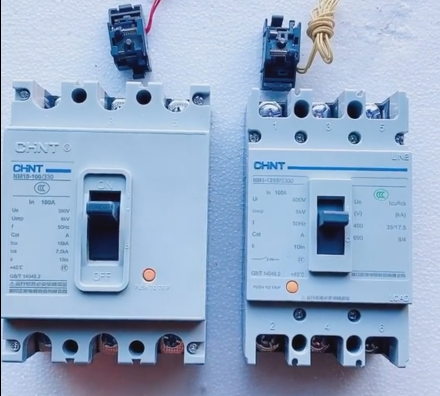Chint NM10 and NM1 series molded case circuit breakers

There are significant differences between Chint NM10 and NM1 series molded case circuit breakers in terms of design positioning, performance parameters and application scenarios.
I. Comparison of core technical parameters
1. **Voltage and current range**
The NM1 series covers a wider voltage range, with a maximum rated working voltage of 690V (415V for 2P products and NM1-63), and a rated current range of 10A to 250A (some models are extended to 1250A). It has outstanding breaking capacity. For example, the rated ultimate short-circuit breaking capacity (Icu) of NM1-125S at 415V reaches 35kA, which is suitable for high-voltage power distribution scenarios.
The NM10 series focuses on low-voltage scenarios, with a rated working voltage of up to 380V and a rated current range of 15A to 600A. Its breaking capacity is relatively low (for example, the Icu of NM10-600 at 380V is 30kA). Its transparent shell models (such as NM10-100H) are specially designed for temporary electricity use in construction sites, allowing intuitive observation of the contact status.
2. **Tripping characteristics and protection functions**
The NM1 series adopts a thermal-magnetic release, with dual protection of overload long-time delay and short-circuit instantaneous, and supports temperature compensation function (for example, NM1-63 can still work stably in the environment of -35℃ to +70℃). The N-pole design of its four-pole circuit breaker is divided into type A (always on) and type B (opening and closing synchronously with other poles), meeting different power distribution needs.
The NM10 series also uses a thermal-magnetic release, but its breaking capacity and protection accuracy are slightly inferior. For example, the rated operational short-circuit breaking capacity (Ics) of NM10-100H is only 15kA, which is suitable for basic power distribution with low requirements on protection accuracy.
3. **Installation and certification**
The NM1 series supports vertical or horizontal installation, with a compact shape (for example, the width of NM1-63 is only 35mm), complies with international standards such as GB/T 14048.2 and IEC 60947-2, and has obtained CCC, KEMA, CB and other certifications.
The NM10 series usually needs to be installed vertically, complies with the GB 14048.2 standard, and is mainly oriented to the domestic market. Some models have passed the CCC certification, but international certifications are not clearly mentioned.
II. Market positioning and product life cycle
1. **NM1 series: high-performance main models**
As the core product of Chint molded case circuit breakers, the NM1 series is widely used in industrial, commercial and residential power distribution systems due to its high breaking capacity (up to 50kA) and intelligent design. However, according to Chint's official announcement, the NM1/NM1LE series was discontinued in May 2025, and the service termination date is November 2025. Users are advised to choose alternative models such as NXM.
2. **NM10 series: economical basic products**
The NM10 series is positioned as an entry-level product, focusing on cost performance and easy installation, and is suitable for scenarios with low requirements on breaking capacity, such as small shops and temporary electricity facilities. Although old models such as NM10-100 have been discontinued, upgraded products are still in production. For example, NM10-100H has improved reliability through structural optimization.
III. Suggestions for selecting application scenarios
1. **Scenarios where NM1 series is preferred**
- When high short-circuit breaking capacity is required for high-voltage power distribution systems (such as 690V industrial power grids).
- When compatibility with international standards (such as export projects) or high requirements on installation flexibility (horizontal/vertical installation) are needed.
- When strict protection accuracy is required, such as industrial environments with frequent starting and stopping of motors.
2. **Scenarios where NM10 series is preferred**
- Low-voltage power distribution (380V and below) with low short-circuit current, such as household distribution boxes and small lighting systems.
- Temporary electricity use or projects with limited budgets. The transparent shell model can monitor the contact status in real time, reducing maintenance costs.
- When it is necessary to quickly replace old equipment (such as DZ10 series) without complex protection functions.
IV. Alternative solutions and purchasing suggestions
- **NM1 alternative models**: NXM series (with a maximum breaking capacity of 70kA, supporting intelligent protection) and NM5S series (electronic trip, supporting IoT monitoring).
- **NM10 alternative models**: NM10 upgraded models (such as NM10-100H) or NM1 series second-hand inventory (attention should be paid to the risk of discontinuation).
- **Purchasing precautions**: The NM1 series has been discontinued, so it is recommended to purchase alternative models first; for the NM10 series, it is necessary to confirm whether it is an upgraded version to avoid buying obsolete models.
Summary
The NM1 series is known for its high performance and international standards, suitable for complex power distribution scenarios, but has entered the phase-out stage; the NM10 series focuses on economy and simplicity and still plays a role in the basic market. Users need to make a comprehensive choice according to the actual voltage level, breaking requirements and budget, and pay attention to the dynamics of the product life cycle to ensure subsequent service support.


